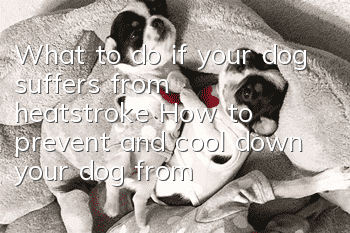What to do if your dog suffers from heatstroke? How to prevent and cool down your dog from heatstroke?

What does heatstroke look like in dogs?
Dogs’ physiques are different from humans. Human skin is covered with sweat glands, and sweating can regulate body temperature very well. Dogs are different. Their entire bodies are covered with fur, and only their tongues and paws have sweat glands, so their heat dissipation efficiency is very low. This summer, the temperature is generally on the high side, and dogs are prone to heat stroke when doing outdoor activities. Heat stroke may cause the dog to die in a short period of time, so please be careful!
Symptoms of heatstroke in dogs
1. Mild heatstroke: shortness of breath, obvious breath sounds, drooling, and restlessness. Able to maintain normal exercise abilities.
2. Difficulty breathing, slow movement, weakness of limbs, and sluggish state. His motor ability has been severely reduced. He lies in one place and does not like to move, but he is able to move around on his own.
3. Epilepsy or coma, showing a state of shock. Loss of movement ability.
First aid after heatstroke
Mild heatstroke: Give your dog water immediately, but not too much or too quickly. Place your dog in a cool area, such as in front of a fan, preferably in an air-conditioned room. Just let the dog recover slowly on its own.
Moderate heat stroke: First, wet the whole body with cold water to quickly lower the body surface temperature. At this time, you can feel that the surface temperature of the dog's skin is relatively high. If possible, it is best to soak the dog in cold water. Note that it is not ice water, just cold tap water. Feed your dog an appropriate amount of water. Then go to the hospital quickly.
Severe heatstroke: For dogs, the probability of death is extremely high. Shower with cold water as soon as possible. You can also try cold water enema or gastric lavage. Apply ice cubes to armpits, neck, and abdomen. Give your dog oxygen to help relieve his respiratory distress. Go to the hospital as soon as possible after emergency treatment, and do not hesitate. Severe heat stroke cannot be solved at home. Pay attention to lowering the dog's head and straightening its neck on the road to keep the dog breathing smoothly, and at the same time, observe whether there is vomiting at any time. When vomiting, be sure not to let the vomitus flow back into the trachea, otherwise it will cause suffocation.
Preventing heatstroke
Corgis’ body hair has a very good thermal insulation effect, so Corgis are very heat-intolerant dogs. When the temperature is above 30C°, Corgis are not suitable for outdoor activities during the day. . Even at night, it is not suitable for long-term strenuous exercise. Pay attention to sun protection during the day. Dogs exposed to direct sunlight will develop symptoms of heat stroke within an hour, which may be life-threatening.
Secondly, make sure you have plenty of drinking water, but never leave a bucket of water outdoors, because the water will heat up quickly, so you should add cold water regularly. You can also feed popsicles appropriately. Never feed ice cream containing milk, not to mention chocolate. Most dogs are lactose intolerant. Eating cream products will cause diarrhea. Chocolate is not good for dogs.It's highly toxic.
Frozen fruits are a good food for dogs to cool down and relieve heat. Just don't eat too much. In addition, you need to pay attention to some fruits that are easy to cause allergies, such as mango, pineapple, etc.
Also, never leave a dog alone in a car in the summer. This should be common sense. If the dog dies because of this, the owner will explode on the spot.
- What do dogs eat to protect their stomach? It is important to protect their stomach and treat gastrointestinal diseases in dogs.
- How to tell if your dog is fat? Is your dog overweight?
- Will your dog catch a cold if you blow the air conditioner? What should you do if your dog catches a cold if you blow the air conditioner?
- What should you pay attention to when your dog drinks water? Don’t be careless when it comes to your dog’s drinking water.
- The dog's mouth bites and shakes. Why does the dog's mouth occasionally shake and bite?
- How to cut a dog's hair? Do you know how to cut a dog's hair correctly?
- Can dogs eat raw eggs? Why can’t dogs eat egg whites?
- Common Dog Problems in Summer How to Deal with Different Dog Problems
- How to keep dogs away from skin diseases. If you do this, will you see if your dog will still be infected with skin diseases?
- What causes anorexia in dogs? Dogs will become anorexic due to lack of exercise. Hounds run at least 5KM every day.



